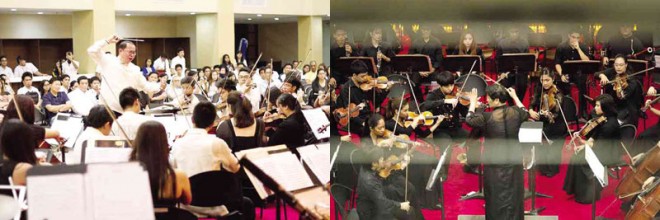
The University of Santo Tomas and University of the Philippines Symphony Orchestras made a historic first by forging a joint full concert billed “No Match” last March 17, at the lobby of the newly erected Buenaventura Garcia Paredes, OP, Building of the UST campus.
UST rector Fr. Herminio V. Dagohoy, OP, called the concert a “rare and exceptional” occasion. He called it a matchless “showcase of the musical might of each school.”
Meanwhile, Ruben David “Dodo” Defeo, artistic director of UP Theater, which houses UP Orchestra as its resident orchestra, referred to the concert as a “collaboration” rather than a “competition;” a sharing of what the combined orchestras could do best: make beautiful music together!
Defeo said the concert was a repeat of the much acclaimed concert the two orchestras mounted at the UP Theater last Feb. 20. He underscored the fact that it took only some 25 days to mount a repeat of the concert. Aside from Defeo, representing UP in the UST concert was Jose Danilo Sivestre, director of the Office for Initiatives in Culture and the Arts.
Raul Sunico, dean of UST Conservatory of Music, informed the audience that the joint concert was the brainchild of Herminigildo Ranera, conductor of UST Symphony Orchestra. Edna Marcil Martinez, conductor of UP Orchestra, readily accepted the proposal to hold a joint concert.
Sunico added that the collaborative concert was part of a continuing partnership between the two schools that started last year with the staging of the opera “Rusalka” at UP Abelardo Hall. Directed by Alegria Ferrer of UP Voice Department, it saw the participation of voice students of UST Conservatory.
Much earlier, UP Madrigal Singers and UST Singers under conductors Mark Carpio and Fidel Calalang Jr. likewise shared the same concert stage at UST Plaza Mayor a few years back when then UST rector Fr. Rolando de la Rosa, OP, tendered a tribute to Alfredo Pascual, an alumnus of UST High School, when the latter became UP president
Indeed, music eclipses differences between institutions and among people of different orientations. Everything and everyone is brought together by the power of music.
The two conductors wielded the baton with supreme authority. Both orchestras played with zest and sparkled with youthful dynamism. The performance venue was enhanced with the simple yet imaginative production design by Fr. Roland Castro, OP.
UP Orchestra played first, rendering a well-selected program highlighted by a Philippine composition. It etched a velvety texture in Sibelius “Andante Festivo,” a single movement for strings and timpani. The familiar Offenbach “Orpheus Overture” was rendered rousingly. The orchestra capped its program by playing with festive splendor a composition of the late National Artist for Music, Antonino Buenaventura, at one time a UST Music dean.
Full sound
UST followed the same format and opened with Shostakovich’s “Festive Overture” with sterling promptness. Having not heard the orchestra for quite some time, I thought it was a different orchestra playing! It has greatly improved! Its playing displayed the stamp of a mature symphony orchestra judging from the luster and depth of the full sound it produced.
The reading of the moving second movement of Tchaikovsky’s “Symphony No. 5” was done with quite mature disposition, despite the musicians’ youthful stance. The performance greatly moved the audience.
Each orchestra highlighted the soloist-caliber of its musicians. Both featured works for solo trumpet.
For UP, Jasper Peralta rendered the trumpet solo in the contemporary work of Leroy Anderson, “Trumpeter’s Lullabye.” Contrasting the contemporary bent of the work, Rafael John Rubio of UST played on baroque trumpet the solo part of Giuseppe Torelli’s dashing “Trumpet Concerto.” Both soloists played with elan.
The two orchestras then combined into one, now numbering 100 players! Together they played well-loved popular symphonic works: Rossini’s “William Tell Overture,” and Sibelius’ symphonic poem, “Finlandia.”
The musicians felt the heat, so to speak and played with biting passion, first under Martinez, who literally stood tall on the podium, wielding the baton with solid dispatch in Rossini’s overture. The audience was bewitched by the familiar refrain that had been adapted by animated cartoon shows on TV.
Ranera in contrast moved the listeners into a deep meditative mood as he etched the hymn-like chorale of Sibelius “Finlandia.” The rendition ravished the heart and caused a big lump in the throat. It was soul quenching, truly a big toast to the mature sensitivity of the combined young musicians.
Here, the principal of each section changed seats that drew applause punctuated with laughter from the appreciative audience. UP musicians sat as principals of each section when the woman conductor wielded the baton. UST principal musicians occupied the same seats when Ranera wielded the baton.
After acknowledging the audience’s applause, Ranera went down the podium cueing the other conductor, Professor Martinez, to lead the combined orchestras for an encore.
After essaying some bars of Johann Strauss Sr. “Radetzky March,” Martinez shared the baton with Ranera, to the appreciation of the audience that marked the beat with stout claps. And when the two conductors shared the podium together, the audience all the more clapped widely.
Truly, the music sounded more celebratory than martial. The fusion of young musical talents from the two leading universities of the country in a collaborative concert is a big cause for celebration. It contributes significantly to the formation of the next generation of leading artists and musicians, as aptly stressed by professor Nenen Espina, who was emcee.
The huge lobby of the new Fr. Buenaventura Garcia Paredes building (named after a Dominican professor of UST who was martyred during the Christian persecutions in Spain in the 1930s and beatified by Pope Benedict XVI in 2007) was an adequate venue for the classical concert, auguring well for similar undertakings in the future.
And why not, indeed! After all, the old gymnasium the new building replaced had been a concert venue frequently attended by Manila’s musical habitués who watched there glorious musical productions, including operas, right after Liberation.